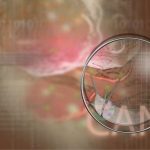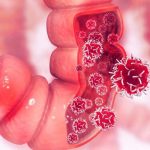
Breast Cancer – Symptoms, Causes & Treatment
Breast cancer is one of the most prevalent types of cancers among women globally as well as in Singapore. According to the Singapore Cancer Registry, 11,805 breast cancer cases were reported in Singapore in the 5-year period between 2015 and 2019, higher than all other reported cancer cases combined among females.
With such a prevalence, breast cancer is among the top health concerns for women. In this comprehensive guide, we will cover all major aspects of breast cancer, including its risk factors, types, stages, symptoms, treatments, and preventive measures. The guide is published for educational purposes only, patients are recommended to seek opinions from their medical oncologist for their situation.
Causes and risk factors of breast cancer
The general cause of cancer is genetic changes in the cells, causing them to grow out of control. Research has not been able to pinpoint exactly what causes these changes. The same applies to breast cancer. Its causes are currently not fully understood.
Scientists, however, have found a range of risk factors that contribute to the likelihood of developing breast cancer. These risk factors can either be modifiable or non-modifiable, which is to say, either in our control to change or out of our control. Let’s start with the risk factors that we cannot change.
Non-modifiable risk factors of breast cancer
1. Gender
Women account for the vast majority of breast cancer cases. However, a small number of men have been found to develop this type of cancer.
2. Age
The risk of developing cancer increases with age, accelerating after the age of 40. In fact, 95% of breast cancer cases are diagnosed in women of 40 years old or above. According to the American Cancer Society, a woman’s odds of developing breast cancer in the next 10 years is one in 200 at the age of 30, but rises to one in 65 from the age of 40, and further increases to one in 28 from the age of 60.
A classic statistic you may come across is that on average one in eight women will develop breast cancer (or one in 13 or 16 according to other sources). Beware that this bare statistic represents an average lifetime risk, which is a total of the risks during different decades of life. Additionally, individual risk factors such as genetics and lifestyle differ from one person to another, altering individual’s risk, as we shall discuss shortly.
3. Race
Scientists found that Caucasian women are more likely to develop breast cancer after the age of 40. With that said, this number only accounts for diagnosed cases. In other words, other races might not have access to appropriate healthcare in order to get diagnosed.
4. Family history
Women who have family members with breast cancer are at a higher risk of developing this disease. The risk is even higher if it is your first-degree relative (e.g., mother, sister).
5. Genetics
Two gene mutations BRCA1, BRCA2 have been associated with hereditary breast cancer. In healthy cells, the purpose of these genes is to express proteins that control cell growth. When mutated, breast tissue cells lose one of their checkpoints, predisposing a person to cancer. As a result, women carrying these genes have an elevated risk of breast cancer.
Around 5–10% of all breast cancer cases have one of these mutations. However, not all inherited mutations in the BRCA1 or BRCA2 gene will develop into breast cancer. The Oncologists often look at multiple factors in addition to genetics to assess an individual’s cancer risk.
6. Radiation exposure
Exposure to radiation is another non-modifiable risk factor of breast cancer. This is usually the result of radiation therapy for another cancer (e.g., Hodgkin’s lymphoma).
7. Age at menstruation
Since scientists found a relationship between female reproductive hormones (e.g., estrogen, progesterone) and breast cancer, the longer a woman menstruates, the higher her risk. For instance, some girls hit puberty at the age of 12, which slightly increases their risk of breast cancer.
8. Age at first birth
According to some studies, women who have their first child at the age of 29 or later have a higher risk of breast cancer. The same applies to women who do not have children at all.
Interestingly, the opposite is true for women with a family history of breast cancer. Differently put, if you have a family history of breast cancer, the longer you wait to have kids, the lower your risk.
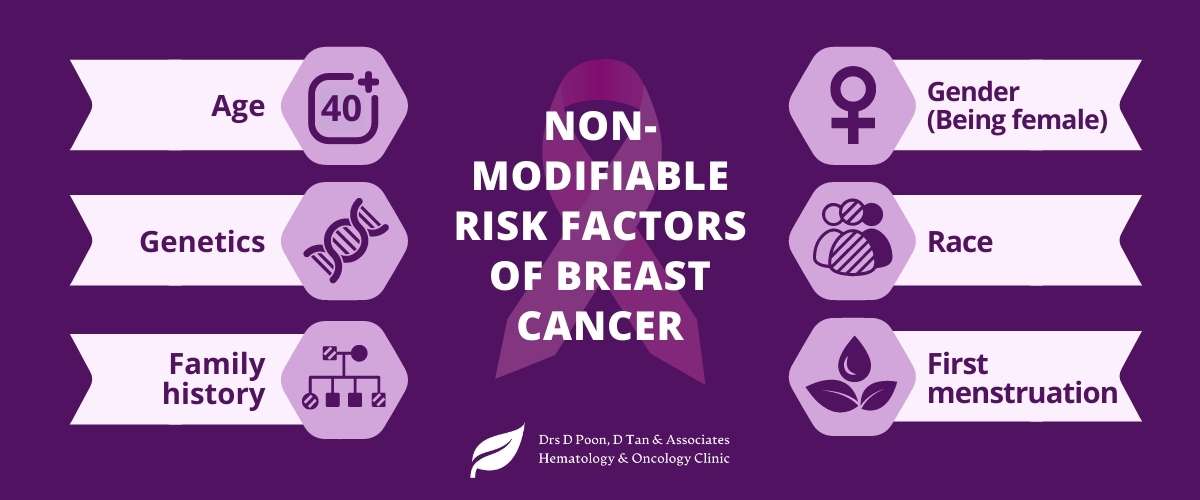
Non-modifiable risk factors of breast cancer
Modifiable risk factors of breast cancer
Now that we have covered the non-modifiable risk factors, let us discuss the ones that we can actually control.
1. Obesity
There is a clear association between elevated body weight and breast cancer. Researchers theorise that obesity promotes excessive production of estrogen, which can increase the risk of breast cancer. When a woman stops menstruating, her levels of hormones drop significantly. However, if she is obese, the fat tissues will keep producing estrogen, augmenting breast cancer risk.
2. Physical activity
Studies showed that women who are physically active have a reduced risk of breast cancer. This is not only because physical activity helps you stay fit. It is believed to have beneficial effects on the body’s inflammatory and immune reaction, helping to lower breast cancer risk.
3. Hormone Replacement Therapy (HRT)
There is growing evidence that hormone replacement therapy elevates the risk of breast cancer. The risk could go up to 26% compared to an average woman. Other studies on local and global scale pointing to the correlation between breast cancer reduction and usage of HRT further substantiate the linkage between HRT and breast cancer.
4. Breastfeeding
Breastfeeding can be a protective factor against breast cancer. The longer you breastfeed your child, the lower your risk.
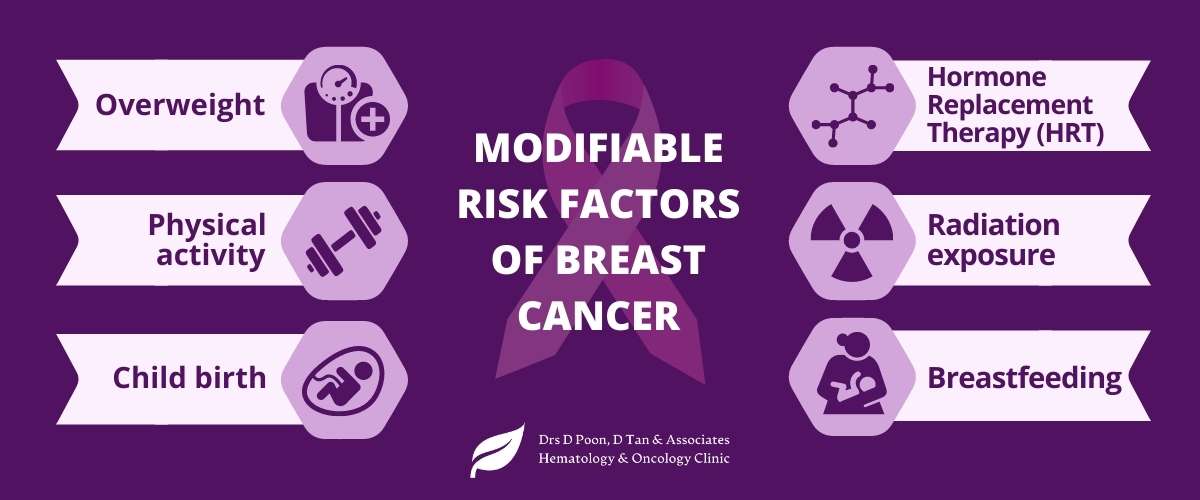
Modifiable risk factors of breast cancer
Breast cancer symptoms
Most patients describe a lump in the breast or their armpit as the first discovered symptom of breast cancer. Besides the classic breast lump, other symptoms include:
- Breast pain that remains constant
- Discoloration of the breast’s skin
- Scaling of the breast’s skin or nipple
- Developing a rash around the nipples
- Bloody discharge from the nipple
- Inverted nipples
- A gradual change in the shape of the breast
The good news is that though a lump in the breast was the first symptom many breast cancer patients notice, most breast lumps do not reveal cancer. Regardless, prompt examination by a healthcare professional is highly recommended.
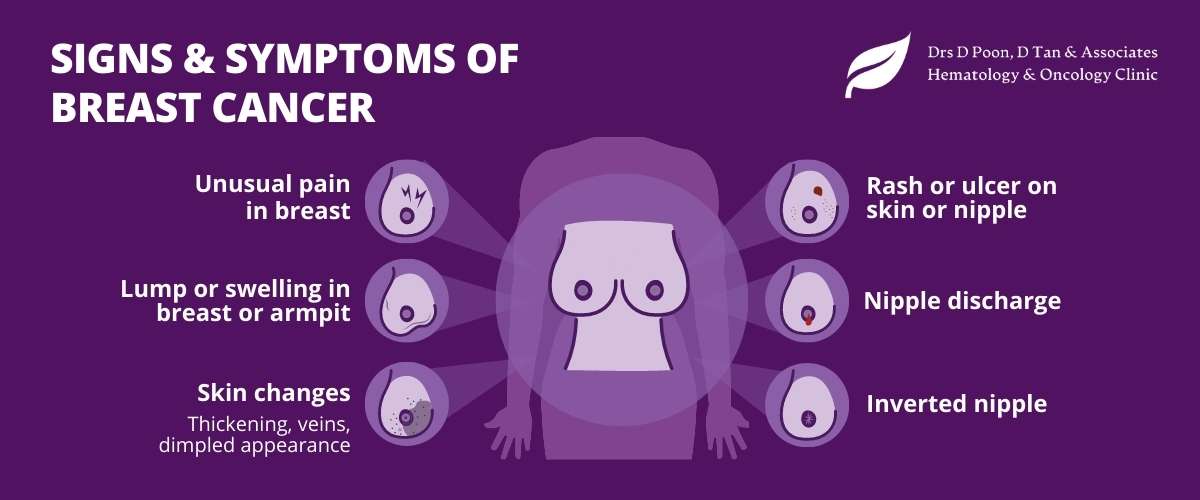
Signs & symptoms of breast cancer
The staging of breast cancer
Oncologists use the TNM (Tumor, Nodes, and Metastases) classification system to determine the stage of your breast cancer. By looking at primary criteria including the size of the tumor and whether it has spread to other lymph nodes.
Below are the commonly used stages of breast cancer:
- Stage 0 – Also known as carcinoma in situ. In plain English, this means that the cancer has not penetrated the breast tissues outside the area where it started. You may also hear this stage referred to as non-invasive cancer.
- Stage 1 – This describes a tumor of up to 2 centimeters (cm) across. The cancer cells have not yet reached the lymph nodes.
- Stage 2 – The tumor’s size is above 2 cm and has spread to the lymph nodes. The other possibility is a tumor size of 2–5 cm without spreading to nearby nodes.
- Stage 3 – At this stage, the tumor size can reach up to 5 cm across with several lymph nodes affected. It can also be larger than 5 cm with only a few lymph nodes affected.
- Stage 4 – The tumor has spread beyond the lymph nodes to other organs (e.g., liver, brain, lungs).
Types of breast cancer
In addition to standard TNM staging, it is important for doctors to find out what breast cancer type a patient has. Knowledge of cancer type helps oncologists understand how cancer has developed in a patient, how it is likely to behave and determine treatment plan.
Depending on whether a breast cancer case is non-invasive (Stage 0) or invasive (Stage 1-4), we have the following common types of breast cancer:
Non-invasive breast cancer types:
- Ductal carcinoma in situ (DCIS): Stage 0 breast cancer that has not spread beyond the milk ducts.
- Lobular carcinoma in situ (LCIS): another stage 0 breast cancer that has not spread beyond the lobules (ie the milk production glands)
Invasive breast cancer types:
- Invasive ductal carcinoma (IDC): IDC started in the milk ducts and has metastasised (spread) to outside tissues, lymph nodes or even organs. This is the most common type of breast cancer, estimated to account for over 50% of all breast cancer diagnosis.
- Invasive lobular carcinoma (ILC): Similar to IDC but started in the milk production glands (the lobules)
- Other rare types of invasive breast cancer include inflammatory breast cancer, angiosarcoma and Paget disease
Recent advances in genomic testing have allowed for better profiling of cancer and therefore better-informed treatment decisions and outcomes for breast cancer patients. For instance, by analysing a sample of the breast cancer tumour for a number of proteins including estrogen, progesterone and HER2 receptors, doctors can further categorise breast cancer as hormone receptor negative or positive.
You may hear terms such as triple negative (TNBC), triple positive or HER2 positive breast cancer. They refer to how cancer cells grow in response to certain hormones commonly associated with breast cancer.
How to diagnose breast cancer
Below are the steps that a cancer doctor often takes to diagnose breast cancer. Some of them can also be taken as part of a routine examination or programmed screening tests.
1. Physical examination of the breast
This focuses on the manual examination of the breast to identify lumps and other features of cancer. Your doctor will instruct you to place your arms in different positions to facilitate locating the lumps.
2. Imaging tests
Imaging techniques remain the best non-invasive method to diagnose breast cancer. The doctor may order:
Mammogram – This is the classic breast cancer screening test. It is a type of X-ray dedicated to the breasts. If there are any signs of malignancy, your doctor will order more tests.
Breast Ultrasound – Using ultrasound waves is helpful in differentiating solid masses from fluid-filled cysts. This is usually ordered after a mammogram.
Breast MRI – MRI scan can be used in addition to mammogram and ultrasound, to help doctors spot tumours of small sizes or in patients with dense breast tissues.
3. Biopsy
A biopsy is considered the gold standard exam to confirm the diagnosis of breast cancer. A sample of the breast tissue is extracted and sent to a laboratory for pathological analysis. The results of this test will determine whether the tumour is malignant (ie., cancerous) or non-malignant. Gene expression profile tests from the sample (such as OncotypeDX, Mammaprint) help doctors further diagnose the type of breast cancer and recommend treatment plans. Find out more about cancer diagnostic tests from our Services section here.
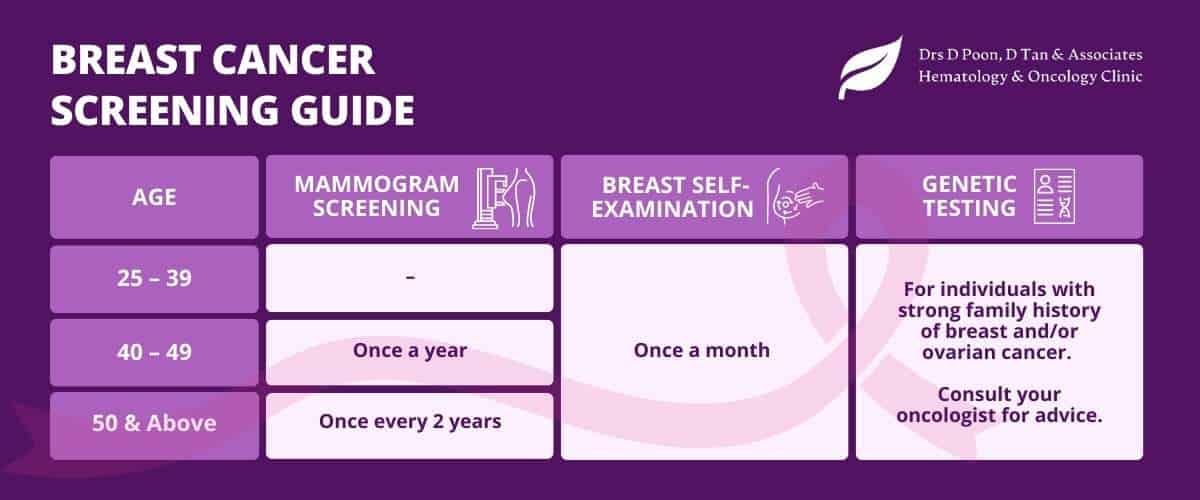
Breast cancer screening guide
Breast cancer treatment
Once a breast cancer is diagnosed, the oncologist will discuss available treatment options and how they could potentially benefit the patient.
In general, available breast cancer treatment includes surgery, radiation, chemotherapy, targeted therapy and hormonal therapy. Each of them are discussed below.
1. Surgery
Breast cancer surgery may be necessary to:
- Remove the majority of the cancer (e.g., mastectomy, lumpectomy)
- Explore the extension of the cancer to surrounding tissues (e.g., lymph nodes)
- Recover the breast’s shape after removing the cancer (i.e. breast reconstruction)
- Palliative surgery to improve the patient’s symptoms
Based on the stage of cancer, the doctor may recommend total removal of the breast (i.e., mastectomy) or a partial ablation (i.e., lumpectomy).
Mastectomy – during this procedure, the surgeon will remove the entirety of your breast, including some surrounding tissues. If the cancer has spread to the other breast, the surgeon may recommend a double mastectomy, where both breasts will be removed.
Other indications of mastectomy include:
- Having two or more tumours in separate areas
- The widespread of malignant-appearing calcium deposits
- Previous radiation therapy to the breast area
- Previous lumpectomy, but the cancer is back at the edges of the surgery
- Being pregnant (radiation therapy may be unacceptable for the unborn child)
- Carrying a genetic mutation that increases the risk of second cancer in the breast
Lumpectomy – Also known as breast-conserving surgery, this is a procedure that focuses on removing only the part of the breast that hosts cancer cells.
When the tumour gets removed, the surgeon will also take out some additional parts of the normal breast tissue. The reason behind this measure is to minimise the risk of relapse. Cancer cells are microscopic, which means that if one cell is hiding in the normal tissue, the patient could develop a new tumour all over again. How much of the breast gets removed is dependent on several factors, including the size and extension of the tumour.
The choice between lumpectomy and mastectomy
During the early stages of breast cancer, your doctor may give you the option to choose between a lumpectomy or a mastectomy. The primary advantage of the first procedure is allowing the patients to conserve most of their breast. In this approach, radiation therapy may be necessary to neutralise any remaining cancer cells.
In cases where the tumour is large, extended, or does not respond to radiation therapy, a mastectomy may be a better option. Women who choose to undergo a mastectomy are also less likely to need radiation, especially when the procedure is done in the early stages.
Despite the common belief that the risk of relapse after a lumpectomy is higher, studies showed that partial removal of the breast followed by radiation therapy leads to similar survival rates to patients who selected a mastectomy. In any case, the choice is highly personal and patients are recommended to discuss the pros and cons of both options with their oncologist before making a decision.
2. Radiation therapy
As discussed in the previous section, the oncologist may recommend radiation therapy after the surgery. The purpose of this procedure is to kill any remaining cancer cells and minimising the risk of recurrence.
3. Chemotherapy
In the past, all breast cancer patients used to receive chemotherapy as a standard treatment. This led to severe adverse effects without always producing the wanted results.
Today, chemotherapy is only necessary for a number of patients. Gene expression testing such as Mammaprint and Oncotype Dx can help identify the genetic mutations a patient has. The results will allow the doctor to prescribe treatment that are tailored for the patient. Learn more about breast cancer patients who do not need chemotherapy in our article here.
4. Targeted therapy & hormonal therapy
Targeted therapy has gained a lot of traction over the past few years. Whether your doctor uses hormone treatments of biological molecules, the chances of positive results are higher. Patients with even aggressive forms of cancer such as triple negative breast cancer (TNBC) have seen improved outlook with targeted therapy.
With results from the gene expression test, the oncologist can identify patients who are likely to benefit from a certain therapy or a combination of different therapies. From there, the doctor may prescribe a drug that targets a specific estrogen receptor to eliminate cancer cells, or recommend certain treatments before t (adjuvant therapy).
Examples of these medications include tamoxifen (Nolvadex), aromatase inhibitors, and goserelin (Zoladex).
Prevention and Screening for breast cancer
The best way to prevent breast cancer is to lower the risk for factors that are in our control and monitor risk factors that are not in our control through cancer screening. Below are a number of suggestions that you can consider to minimise your breast cancer risk.
Exercise
We mentioned above that physical activity could protect you from breast cancer. According to research, regular workouts lower the risk of this disease and improve the outcome of survivors. Keep in mind that the nature of your physical activity is not as important as consistency. Therefore, choose the type of activity that you enjoy.
Quit smoking
Smoking increases the risk of breast cancer in premenopausal women. The mechanism might be inflicting a genetic mutation in the breast tissue cells. Unfortunately, passive smoking (i.e., second-hand smoking) can also increase your risk of cancer. Make sure to speak with your partner about this issue.
Adopt a healthier lifestyle
Processed foods are rich in carcinogenic substances that increase the risk of several cancers. Instead, opt for whole foods that go through little to no processing. Additionally, make sure to get foods rich in antioxidants to neutralize free radicals and aid the body to get rid of toxins. Supplementation may be an option for those with unhealthy/deficient diets.
Regular mammogram tests
In addition to self-examination of the breast – recommended to be conducted monthly, getting a regular mammogram to check for any lump before they manifest physically is an effective way to screen and prevent invasive cancer. This is especially important for women who have relatives with breast cancer. Early identification of breast cancer is absolutely crucial to prevent its spread and progression. Women between the age of 50 and 69 are recommended to go for mammograms once every 2 years. Learn more about cancer screening in our blog article here.
Dr Donald Poon, Medical Oncologist



